Market Overview
The Global Embroidery Market is expected to be valued at
USD 3.3 billion in 2025, and it is further anticipated to reach a market value of
USD 8.0 billion by 2034 at a
CAGR of 10.3%.
The global embroidery market encompasses the production, customization, and distribution of embroidered textiles for fashion, home decor, corporate branding initiatives, and promotional merchandise applications. Embroidery, an age-old art form, has evolved with technology by adopting computerized machines and digital design tools to increase precision and efficiency. Customers seeking unique embroidery patterns across various fabric types drive demand for high-quality, customized apparel, and accessories which push the growth of this market.
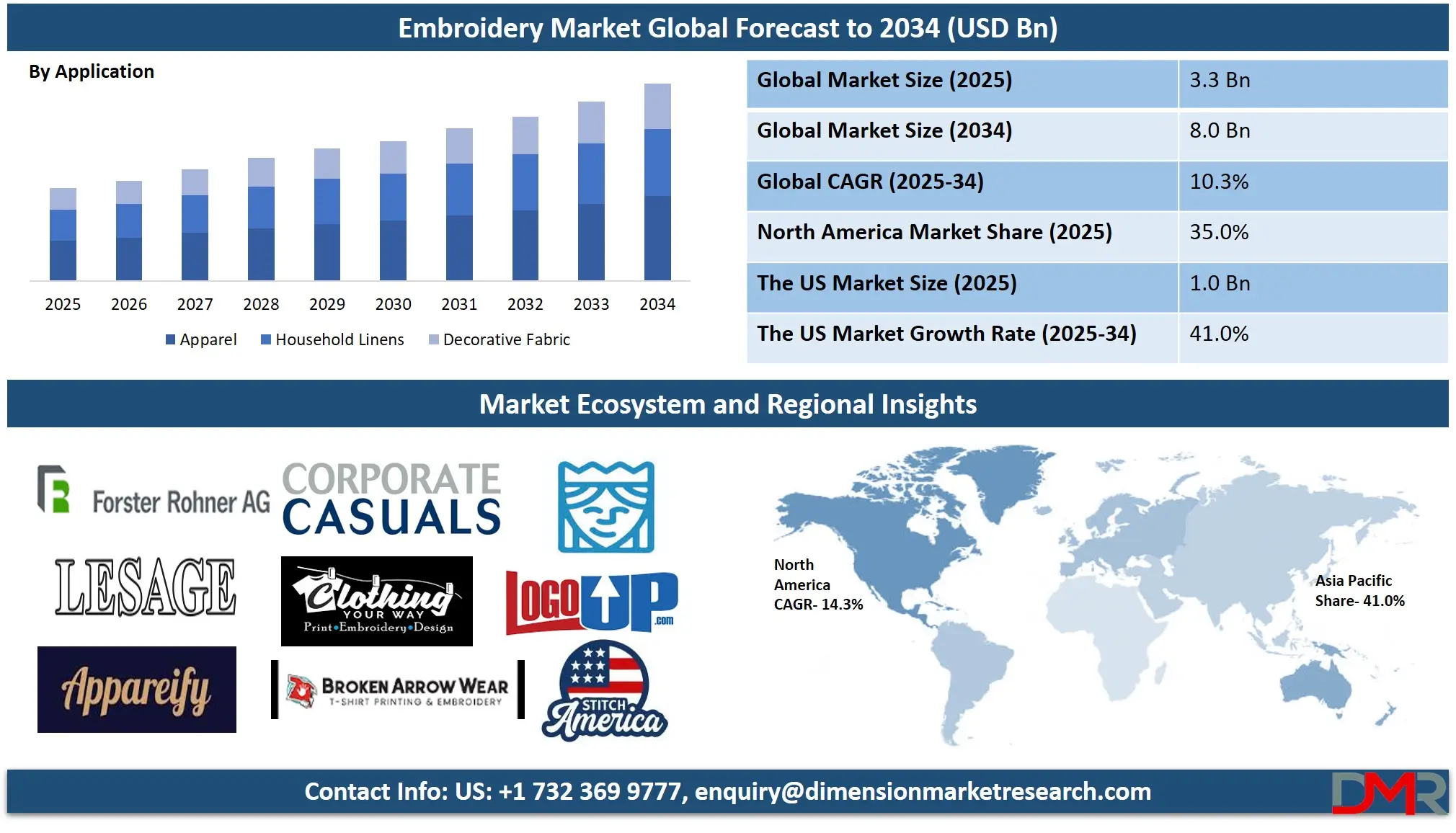
Embroidery has long been used to add texture and embellishment to luxury fashion, sports uniforms, and promotional giveaways. Traditional hand embroidery continues to thrive alongside machine embroidery in regions where craftsmanship is highly esteemed. In recent years, market expansion has been witnessed due to consumers' rising demand for personalized fashion and branded merchandise. Furthermore, the increased popularity of embroidered logos and monograms for corporate and sportswear apparel has only broadened its horizons further.
Additionally, social media and e-commerce platforms have made embroidery products more accessible, enabling both small designers and larger manufacturers to reach global audiences more easily. Custom embroidery services are now widely available online, enabling businesses and individuals to design beautiful embroidery works for personal or commercial use. Businesses often incorporate embroidery into their marketing strategies by including it in promotional materials like hats, bags, or jackets as part of their strategy. Influencer marketing has also contributed to an upsurge in demand for embroidered fashion, as consumers attempt to replicate styles showcased by celebrities and online personalities.
Technological developments have played a critical role in shaping the embroidery industry. Modern computerized embroidery machines have transformed production by improving speed, accuracy, and consistency. Modern innovations like multi-needle machines, AI-driven design software, and digital embroidery techniques have greatly simplified manufacturing operations while keeping embroidery's handcrafted charm alive.
These advancements have also significantly decreased labor costs and production efficiency, making embroidered products more cost-effective for consumers. Furthermore, cloud embroidery design platforms enable designers to collaborate remotely on designs to further broaden their creative possibilities.
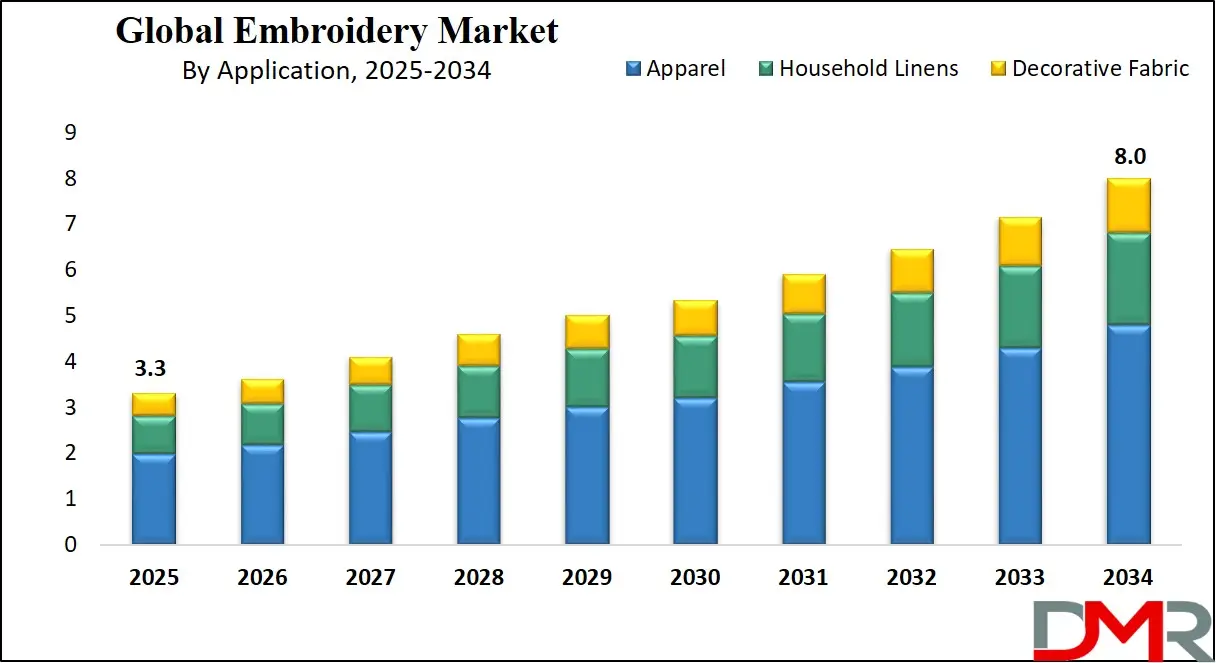
The US Embroidery Market
The US Embroidery Market is projected to be valued at
USD 1.0 billion in 2025. It is further expected to witness subsequent growth in the upcoming period, holding
USD 2.2 billion in 2034 at a
CAGR of 9.7%.
The US embroidery market represents an integral component of the global industry, driven by demand across fashion, corporate branding, and home decor. The US textile and apparel manufacturing industry boasts a robust textile and apparel sector that incorporates embroidery into multiple applications, from high-end designer clothing to mass-produced uniforms, and accessories. With advanced technologies and a strong retail presence, the embroidery industry benefits from an increasing preference for personalized and premium-grade products. Small businesses, craft entrepreneurs, and large manufacturers all play an essential role in expanding the embroidery market by offering customized embroidery services for consumers and corporate clients.
This industry fits within American culture's strong emphasis on branding and identity, where businesses use embroidery logos and insignias to reinforce their presence in the market. Furthermore, embroidery plays an integral part in American sports culture with major leagues such as the NFL, NBA, and MLB sporting embroidered merchandise like jerseys and caps as essential fan gear collections. Recently, the US embroidery market has experienced an exponentially rising surge in demand due to a rise in demand for personalized apparel and promotional products that are being manufactured and distributed. Custom embroidery services offered through e-commerce platforms make ordering personalized apparel, accessories, and home textiles simpler for individuals and businesses.
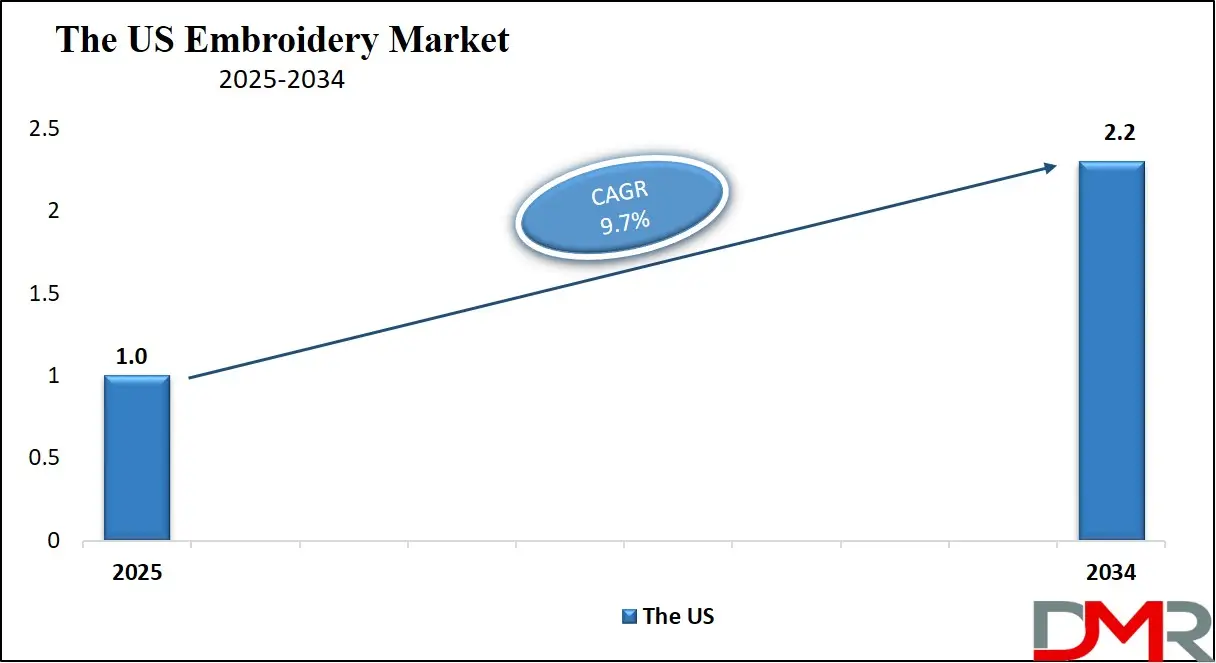
Global Embroidery Market: Key Takeaways
- Market Value: The global embroidery market size is expected to reach a value of USD 8.0 billion by 2034 from a base value of USD 3.3 billion in 2025 at a CAGR of 10.3%.
- By Type Segment Analysis: Counted Thread Embroidery is anticipated to lead in the type segment, capturing 44.8% of the market share in 2025.
- By Application Type Segment Analysis: Apparels are poised to consolidate their market position in the application type segment capturing 60.0% of the total market share in 2025.
- By End-User Type Segment Analysis: Household users are expected to maintain their dominance in the end-user type segment capturing 70.0% of the total market share in 2025.
- Regional Analysis: Asia Pacific is anticipated to lead the global embroidery market landscape with 41.0% of total global market revenue in 2025.
- Key Players: Some key players in the global embroidery market are Forster Rohner AG, Maison Lesage, Appareify, Broken Arrow Custom T-Shirt and Embroidery, Embroidery Your Way, Corporate Casuals, Queensboro Embroidery, LogoUp, Stitch America, and Other Key Players.
Global Embroidery Market: Use Cases
- Corporate Branding & Promotional Merchandise: Businesses globally use embroidery for branding on uniforms, caps, and promotional items like tote bags and jackets. This enhances brand visibility and provides a professional appearance for employees and marketing campaigns. Many companies prefer embroidery over printing due to its durability and premium look. Custom embroidered giveaways at trade shows and corporate events help businesses create lasting impressions.
- Luxury & Fashion Industry: High-end fashion brands incorporate intricate embroidery in couture and ready-to-wear collections. Embellished garments, handbags, and accessories add a sense of exclusivity and craftsmanship, making embroidery a key element in luxury fashion. Designers use hand-stitched embroidery, beads, and sequins to create unique textures and patterns. Fashion houses collaborate with skilled artisans to preserve and promote traditional embroidery techniques.
- Sportswear & Team Apparel: Embroidery is widely used in sports merchandise, including jerseys, hats, and patches for professional, collegiate, and amateur teams. Leagues such as the NFL, NBA, and FIFA incorporate embroidered logos to signify team identity and authenticity. Fans and athletes prefer embroidered logos due to their long-lasting and high-quality finish. Schools and universities use embroidered emblems for varsity jackets and club apparel, reinforcing team spirit.
- Home Decor & Textiles: The embroidery market extends to home furnishings, including embroidered bed linens, curtains, cushions, and tablecloths. Custom embroidery adds a decorative touch to interiors, catering to both mass-market home décor brands and artisanal handmade products. Embroidered monograms and personalized patterns are popular among luxury home décor enthusiasts.
Global Embroidery Market: Stats & Facts
- According to the Ministry of Commerce and Industry of the Government of India, the textile and apparel industry in India holds a 4.0% share of global trade in textiles and apparel.
- According to the Ministry of Commerce and Industry of the Government of India, the domestic apparel and textile industry in India contributes about 2.0% to the country's GDP and 7.0% of industry output in value terms.
- According to Textile Exchange, The US textile industry generates approximately USD 70.0 billion in annual revenues.
- According to Khadi and Village Industries Commission (KVIC), the global textile recycling market, including embroidered textiles, grew at a compound annual growth rate (CAGR) of around 19% during 2014-2019, with continued growth projected during 2020-2025.
Global Embroidery Market: Market Dynamic
Global Embroidery Market: Driving Factors
Rising Demand for Customization and Personalization
People and businesses increasingly desire products with customized designs that reflect personal identity, brand image, or cultural significance. E-commerce and digital embroidery solutions have fueled this trend, making personalized embroidered products easier for customers to create and order, with various colors, fonts, and patterns of their requirements.
Businesses utilize embroidery as a brand differentiation tool, stitched logos create professional looks for employees or promotional giveaways, while sports teams and fan clubs rely heavily on customized-embroidered apparel that represents them as teams or fan clubs. Social media and influencer culture have also played a pivotal role in popularizing personalized embroidery.
Fashion influencers and celebrities often showcase custom embroidered pieces, prompting consumers to seek designs that meet their tastes. Limited-edition collections by major fashion brands also contribute to the demand for exclusive and high-quality products.
Technological Advancements in Embroidery Machinery and Software
Hand embroidery remains highly valued, however, modern automated embroidery machines have significantly accelerated production speed, precision, scalability, and speed of scalability. While multi-needle functionality, laser cut applique, and 3D stitching capabilities have revolutionized this industry, enabling intricate designs with minimum manual labor required to produce them.
AI-powered embroidery design software has revolutionized the customization process, enabling designers to easily and precisely craft complex patterns with greater accuracy. Digital embroidery tools enable users to convert images, texts, and vector graphics directly into stitch patterns for quicker design time and less human error.
Cloud platforms further increase efficiency by providing real-time collaboration between designers and manufacturers, thus streamlining production workflows and streamlining production workflows. Smart embroidery innovations such as conductive thread embroidery for interactive textiles and wearables are creating new opportunities in fashion and technology.
Restraints
High Production Costs and Labor Intensity
Although technological advancements have increased efficiency, embroidery remains an intensive labor process. Hand embroidery can be time-consuming and require artisans with specific expertise to perform, increasing both labor costs and scaling limitations. Machine embroidery involves substantial expenses associated with its high-end equipment maintenance, and software integration costs. Raw material costs can also hinder embroidery production.
Quality embroidery requires premium threads, stabilizers, backing materials, and high-performance machines which add up quickly in terms of production expenses. Furthermore, energy consumption during industrial-grade embroidery production only compounds these expenses, making large-scale production more costly than anticipated. Another challenge lies in finding qualified machine operators and embroidery digitizers. While automation has made some tasks simpler, programming embroidery machines and fine-tuning stitch patterns still require experienced professionals.
Competition from Alternative Textile Decoration Techniques
A challenge to embroidery's growth in the global market is competition from alternative textile decoration techniques like direct-to-garment (DTG) printing, screen printing, heat transfer printing, and sublimation printing. These methods offer cost-effective production options with fast production times that appeal to businesses and consumers looking for budget-friendly customization solutions without stitching thread into fabric, like embroidery.
Printing techniques allow detailed, full-color designs on garments without incurring additional expenses for thread, stabilizers, or intricate machine works. DTG and sublimation printing techniques, in particular, have become increasingly popular due to their ability to produce photorealistic and highly detailed prints that embroidery simply cannot replicate. These techniques are also more scalable for mass production, making them the preferred choice for industries requiring large quantities of customized apparel, such as promotional merchandise, event-based marketing, and fast fashion.
Opportunities
Rising Demand for Sustainable and Eco-Friendly Embroidery Solutions
As consumers and businesses become more environmentally conscious, there has been an upsurge in demand for organic materials, recycled threads, and eco-friendly production practices which ties in with global sustainability trends as industries like fashion and home decor are under pressure to reduce carbon emissions and minimize waste production.
Eco-friendly embroidery materials such as organic cotton threads, recycled polyester yarn, and biodegradable stabilizers offer manufacturers an opportunity to differentiate their products in an environmentally conscious marketplace. Companies that adopt sustainable practices like using energy-efficient machines for dyeing processes or using less water during dyeing processes may attract eco-conscious customers while meeting the sustainability goals of brands or aligning their product offerings accordingly. Furthermore, sustainable embroidery may even become part of luxury and high-end fashion markets where consumers will pay for ethically made, environmentally friendly products.
Growth in Customized and Personalized E-Commerce Platforms
Due to online shopping and increasing consumer desire for unique, personalized items, custom embroidery has flourished rapidly since 2008. Businesses using such platforms offer personalized embroidery on clothing and home textile products across a global scope.
Customers can design and order customized embroidered items directly from their homes without incurring extra shipping charges, creating convenience while driving sales growth. With the rise of online customization tools allowing customers to upload designs or select from templates to personalize products, embroidery businesses have an opportunity to leverage digital space and compete against larger businesses and independent designers in providing unique embroidery designs for gifts, special occasions, and branded merchandise.
Print-on-demand and drop shipping services have also emerged as key parts of this customization trend, providing many companies with on-demand customization without incurring inventory investment risks.
Trends
Integration of Smart and Wearable Embroidery
As demand for smart textiles with embedded LEDs or conductive threads grows, their incorporation has evolved into garments and accessories such as clothing with LED patterns or temperature regulation or health monitoring wearables. Thread embroidery makes use of conductive threads to form functional circuits that connect sensors, batteries, and microchips to transform traditional fabrics into interactive surfaces.
For instance, jackets and shirts fitted with embedded sensors can monitor body temperature, heart rate, or posture to provide valuable data for fitness or medical applications opening up new markets for embroidery industry products in sectors like sportswear, performance gear, and medical textiles. Wearable technology presents embroidery companies with an opportunity to adapt and innovate products that combine style with advanced technology, becoming more engaging for all wearables customers while meeting consumer demand for multifunctional clothing products.
Revival of Traditional Hand Embroidery Techniques
As consumers seek authentic, artisanal, and heritage-inspired products, one key trend in the global embroidery market is the revival of traditional hand embroidery techniques. While machine embroidery has long dominated this sector, there has been an appreciation of handcrafted work which often bears cultural significance or tells a particular tale particularly strong among fashion and home decor consumers who view hand-embroidered garments, accessories, and textiles as masterpieces.
This trend can especially be found within apparel manufacturing as customers search for products with personality. Craftsmanship and hand embroidery have long been recognized by high-end designers and luxury brands, who embrace its artistry to craft exclusive bespoke pieces using traditional techniques. Social media platforms, especially Instagram and Pinterest, have played an instrumental role in elevating hand embroidery as a craft, with users posting DIY projects and showing off artisanal goods on these channels.
Global Embroidery Market: Research Scope and Analysis
By Type
Counted thread embroidery is projected to lead the global embroidery market in 2025, capturing an estimated 44.8% of the market share. This form of embroidering is highly prized due to its accuracy and versatility. As its primary function, needlework is used for creating intricate designs, cross-stitch patterns, or similar styles. Counted thread embroidery's popularity can be attributed to both traditional and modern applications, and an increase in personalized and customized embroidery for fashion, home decor, and promotional purposes.
One factor contributing to counted thread embroidery's continued prominence is its adaptability in creating products like monogrammed clothing, personalized accessories, and home decor. As consumers seek unique and tailored items more frequently, the demand for counted thread embroidery should increase significantly across the fashion and home textile sectors.
Outline embroidery is expected to experience significant growth in market demand. Outline embroidery involves stitching the outline of designs or patterns and is becoming more and more popular due to its elegant simplicity and minimalist appeal. It is frequently used in clothing designs that add clean and refined appearances with garments and accessories, while its versatility makes it suitable for fashion as well as interior design applications since its style fits both modern and classic interior styles.
Part of the wider slow fashion movement, outline embroidery is becoming a popular way of producing items that highlight craftsmanship. Consumers who value sustainability and individuality are turning towards this form of embroidery as it allows them to add subtle yet striking details on garments, accessories, and home textiles.
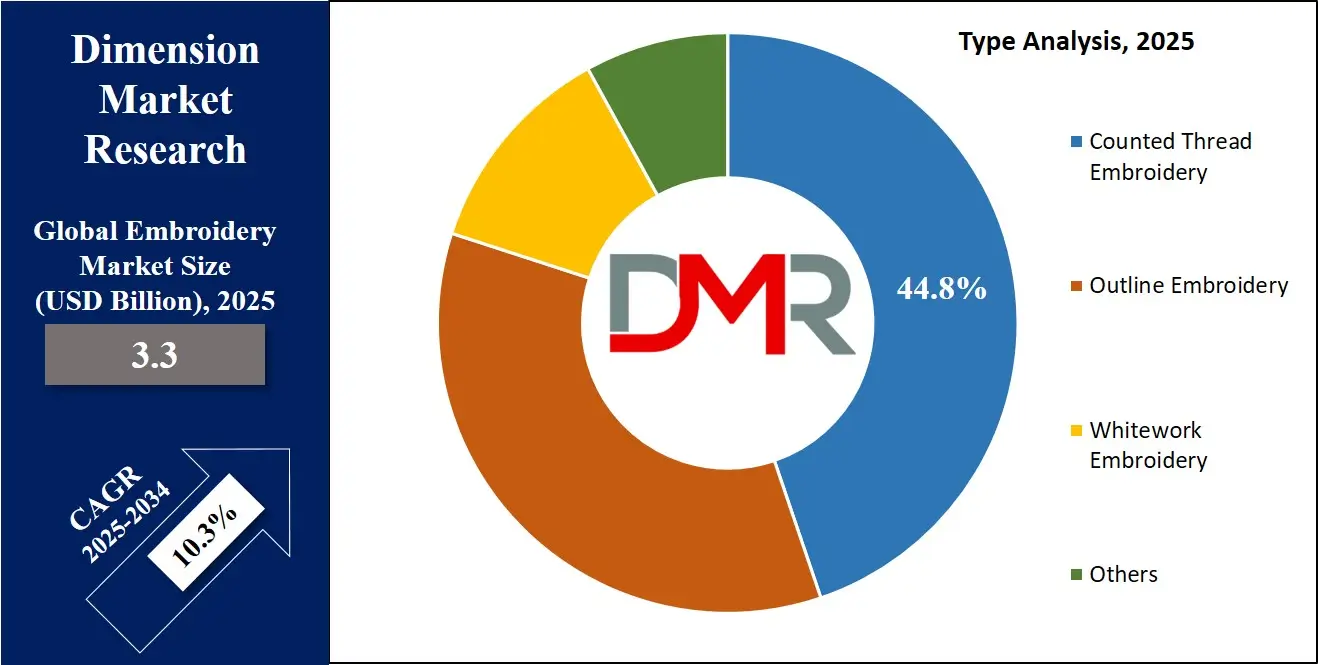
By Application
Apparel is projected to strengthen its dominant position in the global embroidery market by capturing
60.0% of the total market share in 2025. This growth is fueled by continued demand for embroidered designs in the fashion and clothing industries. Embroidery has long been used as a way of adding personalization, sophistication, and quality to mass-produced apparel as well as luxury brands.
As consumer preferences move toward custom and bespoke items, embroidered apparel such as T-shirts, jackets, dresses, and hats has become an essential market segment. Additionally, the growth of online platforms offering custom embroidery services allows users to design their personalized clothing with ease. Embroidery can be applied to a range of fabric types from casual wear to high-end couture, making it a preferred choice for designers.
Household linens are poised for a significant resurgence in market share within the embroidery industry. Consumers desire personalized home textiles like bed linens, towels, tablecloths, and curtains that add elegance and personalization to their home decor.
Demand for eco-friendly home goods has led to the rapid expansion of embroidered household linens. Consumers favor premium, eco-conscious textiles like those crafted from organic or recycled fabrics. As home decor trends continue to embrace customization, embroidered linens provide consumers with an opportunity to add personalization touches to their own homes thus further propelling this segment's market growth.
By End-User
Household users are expected to maintain their dominance in the end-user type segment capturing 70.0% of the total market share by the end of 2025. This can be attributed to increasing consumer demand for embroidered home textiles such as bed linens, towels, curtains, and tablecloths. Embroidery adds a personalized touch and elevates the aesthetic appeal of decor in homes.
As consumers seek unique yet high-quality customized products for their living spaces embroidered textiles offer luxurious yet distinct options and have become particularly prevalent within premium home decor markets. As consumers' desire for personalization increases, household consumers are seeking products with embroideries that reflect their unique tastes, from monogrammed towels to intricately designed throw pillows. Furthermore, the trend toward eco-friendly home goods has encouraged consumers to buy items made from organic or recycled fabrics.
Household users are expected to see a rise in embroidery usage. Hospitality and corporate industries, particularly hotels, are adopting embroidery for uniforms, linens, and promotional merchandise creating an elegant experience while simultaneously branding themselves through logos or custom designs.
Corporate businesses have increasingly turned to customized embroidered products as part of their branding and employee engagement strategies, with uniforms featuring logos emblazoned with company branding as popular ways of projecting a professional image and reinforcing brand identity.
The Embroidery Market Report is segmented on the basis of the following:
By Type
- Counted Thread Embroidery
- Outline Embroidery
- White Embroidery
- Others
By Application
- Apparel
- Household Linens
- Decorative Fabrics
By End-User
Global Embroidery Market: Regional Analysis
The region with the largest Revenue Share
Asia Pacific is expected to dominate the global embroidery market in 2025, capturing
41.0% of the total global market revenue. Asia Pacific boasts a highly developed infrastructure for textile production, with countries like China, India, and Bangladesh serving as major hubs of both apparel and home textile production. These countries not only boast access to affordable labor but also possess skilled artisans and large-scale manufacturing capacities that enable the region to maintain its leadership in the embroidery market.
The region's markets have also experienced an increase in demand for embroidered products used for fashion, home decor, and promotional purposes. Asia Pacific's extensive textile and apparel industries contribute significantly to the rapid expansion of embroidery markets.
E-commerce platforms have also played an instrumental role in driving market growth by giving consumers easier access to customized and embroidered products. Digital platforms have enabled consumers to design custom apparel and home goods using personalized design capabilities, this has given a huge boost to markets where middle-class populations have expanded exponentially embracing personalized consumer goods.
The region with the highest CAGR
North America is expected to experience the highest CAGR in the global embroidery market due to increasing demand for embroideries across industries including fashion, sportswear, and home decor products in this region. North American consumers increasingly seek unique, high-quality, and personalized products something which is fuelling the expansion of the embroidery market.
Customization, with consumers seeking to add personalized logos, monograms, or designs to clothing and accessories is becoming a popular trend across this region. The region's rising emphasis on sustainability and ethical consumerism is fuelling the market growth for embroidered goods. As consumers become more focused on eco-friendly, durable, locally made goods with minimal environmental impacts, and added unique value, embroidery has become an attractive choice among consumers in North America.
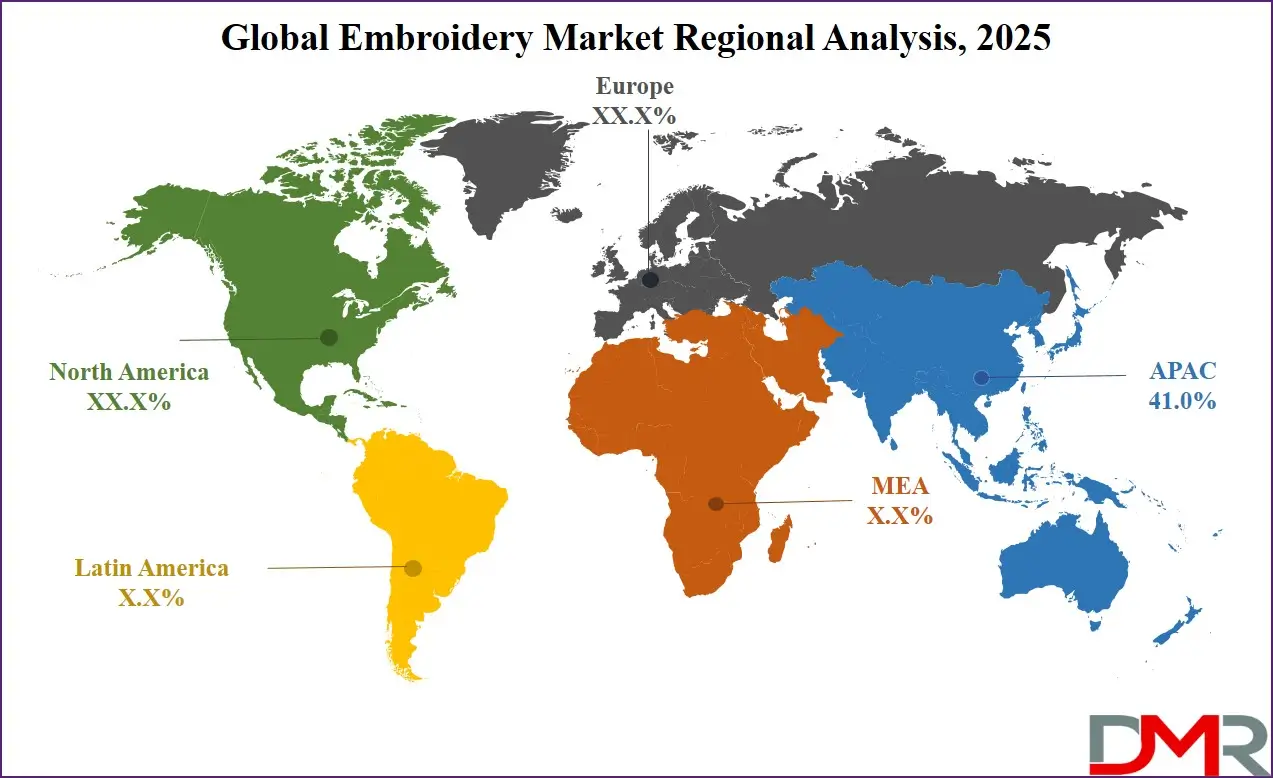
By Region
North America
Europe
- Germany
- The U.K.
- France
- Italy
- Russia
- Spain
- Benelux
- Nordic
- Rest of Europe
Asia-Pacific
- China
- Japan
- South Korea
- India
- ANZ
- ASEAN
- Rest of Asia-Pacific
Latin America
• Brazil
• Mexico
• Argentina
• Colombia
• Rest of Latin America
Middle East & Africa
- Saudi Arabia
- UAE
- South Africa
- Israel
- Egypt
- Rest of MEA
Global Embroidery Market: Competitive Landscape
The global embroidery market is marked by an unpredictable and fragmented competitive environment, with multiple players operating across numerous regions competing for market share through product innovation, technological advancements, and strategic partnerships.
Companies in this market include both multinational corporations and small to medium-sized enterprises (SMEs) that specialize in various aspects of embroidery including machine, hand, and digital embroidery processes. Companies increasingly prioritize meeting consumer demand for personalized high-quality embroidered products which has become a differentiating factor within this industry.
Leading players in the competitive landscape often prioritize developing cutting-edge embroidery technology, such as computerized machines, automated systems, and high-speed production tools which increase speed and precision while decreasing costs.
Companies such as Brother Industries, Bernina International, and Melco Embroidery Systems are known for producing innovative embroidery equipment and machinery. These companies are using technology to develop systems that offer high-level customization, ease of use, and efficiency to address the rising need for mass customization of personalized embroidered goods across sectors such as fashion, home textiles, and promotional merchandise.
Research and development (R&D) spending among players in the market is increasing as companies invest in innovative embroidery techniques and materials, such as smart textiles with embedded electronics.
Manufacturers are using such advances to cater to emerging markets such as wearable tech, sportswear, and medical textiles which demand both functionality and design features which is driving competition among firms as they attempt to gain an edge by offering cutting-edge solutions tailored specifically towards consumer demand.
Some of the prominent players in the global embroidery market are:
- Forster Rohner AG
- Maison Lesage
- Appareify
- Broken Arrow Custom T-Shirt and Embroidery
- Embroidery Your Way
- Corporate Casuals
- Queensboro Embroidery
- LogoUp
- Stitch America
- Other Key Players
Global Embroidery Market: Recent Developments
- June 2023: ZSK Stickmaschinen GmbH, entered a partnership with STOLL, a high-tech knitting machine company, to merge their embroidery and knitting technologies. The collaboration aims to combine their expertise in textile manufacturing, providing customers with enhanced embroidery and knitted designs that are both efficient and innovative.
- September 2022: Epson unveiled its new line of SureColor F-Series sublimation printers with advanced embroidery features. The launch aims to help small businesses and entrepreneurs create high-quality customized embroidered products for various industries, including fashion and promotional items. The system integrates embroidery capabilities for seamless customization.
- March 2021: Hohenstein Institute partnered with BASF to introduce an innovative thread made from sustainable materials, aiming to offer eco-friendly solutions to the embroidery market. This collaboration focuses on reducing the environmental impact of embroidered textiles by providing sustainable alternatives without compromising on performance and quality.
Report Details
| Report Characteristics |
| Market Size (2025) |
USD 3.3 Bn |
| Forecast Value (2034) |
USD 8.0 Bn |
| CAGR (2025-2034) |
10.3% |
| Historical Data |
2019 – 2024 |
| The US Market Size (2025) |
USD 1.0 Bn |
| Forecast Data |
2026 – 2034 |
| Base Year |
2024 |
| Estimate Year |
2025 |
| Report Coverage |
Market Revenue Estimation, Market Dynamics, Competitive Landscape, Growth Factors and etc. |
| Segments Covered |
By Type (Counted Thread Embroidery, Outline Embroidery, Whitework Embroidery, and Others), By Application (Apparel, Household Linens, and Decorative Fabric), and By End-User (Household, and Commercial) |
| Regional Coverage |
North America – The US and Canada; Europe – Germany, The UK, France, Russia, Spain, Italy, Benelux, Nordic, & Rest of Europe; Asia- Pacific– China, Japan, South Korea, India, ANZ, ASEAN, Rest of APAC; Latin America – Brazil, Mexico, Argentina, Colombia, Rest of Latin America; Middle East & Africa – Saudi Arabia, UAE, South Africa, Turkey, Egypt, Israel, & Rest of MEA
|
| Prominent Players |
Forster Rohner AG, Maison Lesage, Appareify, Broken Arrow Custom T-Shirt and Embroidery, Embroidery Your Way, Corporate Casuals, Queensboro Embroidery, LogoUp, Stitch America, and Other Key Players |
| Purchase Options |
We have three licenses to opt for: Single User License (Limited to 1 user), Multi-User License (Up to 5 Users) and Corporate Use License (Unlimited User) along with free report customization equivalent to 0 analyst working days, 3 analysts working days and 5 analysts working days respectively. |
Frequently Asked Questions
The global embroidery market size is estimated to have a value of USD 3.3 billion in 2025 and is expected to reach USD 8.0 billion by the end of 2034.
The US embroidery market is projected to be valued at USD 1.0 billion in 2025. It is expected to witness subsequent growth in the upcoming period as it holds USD 2.2 billion in 2034 at a CAGR of 9.7%.
Asia Pacific is expected to have the largest market share in the global embroidery market with a share of about 41.0% in 2025.
Some of the major key players in the global embroidery market are Forster Rohner AG, Maison Lesage, Appareify, Broken Arrow Custom T-Shirt and Embroidery, Embroidery Your Way, Corporate Casuals, Queensboro Embroidery, LogoUp, Stitch America, and many others.
The market is growing at a CAGR of 10.3 percent over the forecasted period.